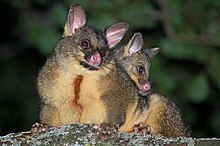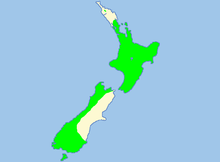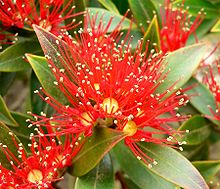South Island ironwood
| South Island ironwood | ||||||||||||
|---|---|---|---|---|---|---|---|---|---|---|---|---|

South Island ironwood ( Metrosideros umbellata ) |
||||||||||||
| Systematics | ||||||||||||
|
||||||||||||
| Scientific name | ||||||||||||
| Metrosideros umbellata | ||||||||||||
| Cav. |
The South Island ironwood ( Metrosideros umbellata ), in Māori “rātā” , English “southern rata” , German occasionally also “Southern Rata” , is one of the most famous tree species in New Zealand , along with the North Island ironwood and Pohutukawa from the same genus . It is particularly striking because of the bright red flowers that appear in December and January. The home especially in the South Island of New Zealand populations are by browsing through the introduced from Australia possum threatened.
description
Habitus
The evergreen South Island ironwood trees are 15 meters and higher and can reach a trunk diameter of more than one meter, but together with the down-growing aerial roots this can still be exceeded considerably. The trunks have a 2 to 3 mm thick bark, the outer layers of which fall off in paper-like pieces. The habitus can, however, differ greatly from this appearance depending on the location. While mostly free-standing trees have a round tree shape, trees in more densely populated habitats form an umbrella-shaped crown. On overgrown banks, South Island ironwood trees often grow with an almost horizontal trunk to grow out from under the canopy of other trees. In some cases, plants on extremely stony ground are only bush-like and bloom at a size of 15 to 25 cm. Occasionally, epiphytic specimens are found in the crowns of Libocedrus bidwillii and, more rarely, of Podocarpus hallii or Dacrydium cupressinum . These trees are heavily branched above the original point of attachment; the roots growing downwards increasingly envelop the host, sometimes so much that it dies.
Vegetative growth
The initially velvety, later smooth, leathery leaves have a size of (25–) 30–50 (–60) mm × (10–) 15–20 mm are opposite , without stipules and sit on about 5 mm long petioles. The leaf shape varies from medium to narrow oval or elliptical.
Adult plants end a vegetative growth spurt with the formation of a vegetative pair of buds, which are opposite to the last pair of leaves between them. They consist of five to six pairs of modified, scale-like leaves, of which the second pair completely encloses the bud. These buds are 1.5 mm long and resinous during winter. In the spring the resin loosens, the two outer pairs of scales are shed, the remaining three to four pairs initially enlarge to protect the developing leaves until they are shed too.
Younger plants do not develop any vegetative buds at the end of the growing season, although here too the growth ends with the formation of a pair of leaves. However, this is often not fully developed and dies off during winter.
The vegetative growth is mostly limited to the leaves that have already formed in the vegetative buds, so that only two to four pairs of leaves with the corresponding nodes are formed per growth period. The branching of the shoots is mostly dichotomous . The division of the shoot of young seedlings usually begins after the fourth growth period.
The annual rings in the trunk appear at annual intervals, at least in young plants; the lighter, earlier wood alternates with the darker wood of the later growth phase. After about 50–100 annual rings the growth becomes irregular, in some rings regular growth can be seen, while in others the growth has almost ceased and the transitions are difficult to see.
The roots growing in the ground are very thin, often only 0.2 mm thick, and have many branches. Since most of the shoot tips of the roots are very short-lived, they are replaced by new roots that grow outward from the center of the plant. If root hairs are present, they are only sporadically or closely bundled and become 0.5 mm long.
If the South Island ironwood grows in humid areas, especially in the valleys below the Franz Josef and Fox Glaciers , aerial roots form in plants with a trunk thickness of at least 23-30 cm . In this size the plants are already around 100 years old. These aerial roots initially hang freely or grow down from the trunk. If they reach the ground, they thicken into stilt roots and often grow together with other aerial or stilt roots or the trunk.
Even if plants in the lowlands mostly have well-developed aerial root systems, the plants die in almost all cases when they topple over, while new trees often grow out of the trunks at higher altitudes, so that they form a dense tangle of fallen and wedged trunks.
Multiplication
The flowering time of the South Island ironwood can vary widely even within a habitat. While the main flowering season is in December and January, some flowering trees can be seen beyond March.
The flowers form individually or in groups of two to three in the armpits of the inner one to three (mostly two) bud scales, individual flowers are faced with a leaf, flower groups a whorl of four to six leaves. The vegetative shoot of the bud usually stops growing before the flower opens, and since the flower stalks are usually longer than the internodes , it seems as if the flowers appear in groups of up to nine flowers.
The flowers consist of five approximately 3 mm long, oblong triangular to oval sepals and five approximately 5 mm long, almost round red petals . The numerous red stamens are about 2 cm long. There are also isolated plants with orange to yellow flowers. The base of the stylus is slightly above the placenta.
The flowers, which are rich in nectar , are mainly sought out and fertilized by the Tui ( Prosthemadera novaeseelandiae ) and the Korimako ( Anthornis melanura ) as well as by honey bees .
Seed pods 0.75 to 1 cm in size develop from the fertilized flowers. This makes them larger than those of related species such as North Island ironwood or Pohutukawa . During the growth of the capsules, the tissue between the stylus and the placenta enlarges so that they are far apart in completely formed capsules. The green capsules containing around 250 to 300 seeds are ripe in the summer following flowering, as is the case with most myrtle plants , only a few of the seeds contain embryos and are viable. During the winter the seed pods burst open, so that the following November the seed pods are almost empty. The seeds, which are only 2.0 × 0.4 mm in size and weigh less than 0.1 mg, are distributed by the wind. Empty capsules will remain on the plant for a few months before they fall off.
Age
Correlations with glacial data of the adjacent glaciers from the valleys of the Fox River and the Waiho River suggest that the South Island ironwood trees have a lifespan of 400 to 500 years.
Chromosome number
The number of chromosomes is 2n = 22.
Distribution and habitat
The South Island ironwood is the most widespread member of the Metrosideros genus in New Zealand . It is mostly found at altitudes between 0 and 760 meters above sea level, on cliffs facing northwards, some stocks are also known at altitudes over 1100 meters. It grows best in cooler regions with a high average rainfall, so it is mainly found on the west coast of New Zealand's South Island. However, there are also some habitats on the entire North Island, for example on the Coromandel Peninsula and the northern highlands, the southernmost occurrences are to be found on the sub-Antarctic Auckland Islands , making them the southernmost forests in New Zealand.
Typically, the South Island ironwood is associated with other trees such as the "Kamahi" ( Weinmannia racemosa ), the stone slice species Podocarpus hallii or the "Berg Neinei" ( Dracophyllum traversii ) and shrubs such as various Coprosma and Pseudopanax species. In the fern and herb layer there are, for example, various ferns of the genus Blechnum , as well as Gleichenia cunninghamii , the sour grass family Gahnia procera , the daylily family Phormium cookianum , the red family Nertera dichondraefolia or Astelia nervosa from the family Asteliaceae .
Since young seedlings of South Island ironwood find it difficult to compete with other plants, South Island ironwood trees are often found in sparsely populated areas with poor soils or otherwise harsh environmental conditions. Due to their ability to lead an epiphytic way of life, the plants are also found occasionally, but in small proportions, in more densely populated habitats. As a stone-mounted plant, specimens can be found on limestone , slate , greywacke , andesite , gneiss , granite and quartzite .
Systematics
The genus Metrosideros is divided into two subgenus, the subgenus Metrosideros with about 26 species and the subgenus Mearnsia with about 24 species. Phylogenetic studies have shown that the South Island ironwood ( Metrosideros umbellata ) is at the basal point of the subgenus Metrosideros and is therefore also basal for three independent tribes within the subgenus. Four species of the subgenus are endemic to New Zealand, five to Hawaii and seven to New Caledonia . It is assumed that the species in New Caledonia first emerged from Metrosideros umbellata , followed by the other New Zealand species later. The subgenus spread from New Caledonia in the western Pacific, the probably youngest Hawaiian species probably have their ancestors in New Zealand. This theory of the distribution of the subgenus based on Metrosideros umbellata is supported by the phylogenetic division into three strains. The wide distribution of the genus over the Pacific region starting from New Zealand is attributed to various ice age weather phenomena that are comparable to today's El Niño .
Danger

Since the 1950s, increased forest death within the South Island ironwood populations has been noted and studied. Sometimes over 30% of the trees in a population have died. The main cause is the browsing by mammals introduced to New Zealand, especially the Australian brushless kusu ( Trichosurus vulpecula ). But larger mammals such as the red deer ( Cervus elaphus scoticus ) also use the plants as food. The trees weakened by browsing are consequently more susceptible to wind damage, fungal and insect infestation, and drought. The death rate of ironwood trees varies greatly from population to population. On the one hand, populations where there is a lack of hardwood bushes in the undergrowth appear to be particularly susceptible to browsing by the fox cusus; on the other hand, older trees are more likely to die than younger specimens as a result of browsing. Since the Foxes often seek out already weakened trees to eat, individual trees in a population often die off completely, while others are still completely healthy.
To curb the damage caused by the fox kusu, various programs have been started to reduce the number of animals. For this purpose, among other things, bait dropped by plane or hand-laid, poisoned bait was used, but traps were also set. Fences are also being erected, but this can be expensive and ineffective, especially for larger areas. Single trees can be protected by a metal ring around the trunk. From 1951 to 1961, the New Zealand government paid a premium for fox kusu. However, since these were mostly caught in easily accessible areas that were hardly home to endangered plants, this method had proven to be too ineffective and was discontinued.
Almost completely destroyed forest areas, which were previously largely populated by South Island ironwood and Kamahi ( Weinmannia racemosa ), were unable to regenerate in this area even after the foxkusu numbers declined . After the destruction of the originally predominant plants, mainly those plants settled there that are not eaten by the fox kusu, such as Quintinia acutifolia .
Origin of name
The scientific generic name Metrosideros is derived from the Greek metra meaning uterus, marrow, core of plants (to metra mother) and from sideros (iron), which refers to the extremely hard wood. The type epitheton umbellata means "bearing umbellate " and refers to the umbrella-shaped flowers that arise from a single inflorescence stalk.
Economic importance
The South Island ironwood trees are of little economic importance, but because of their main flowering time in December and the characteristic, striking red flowers, they are associated with Christmas together with the Pohutukawa and North Island ironwood . Although the wood of the South Island ironwood is very hard and belongs to the wood class of ironwoods , the wood is only very rarely used as precious wood . The main reason for this is the mostly very strong ossified shape of the trees, specimens that have grown straight enough are very rare. The honey obtained from the flowers is offered as "rata honey", the wood is partly used as firewood.
Web links
- Metrosideros umbellata in the Flora of New Zealand
- Project Crimson - Project to conserve the ironwood and pohutukawa trees
Individual evidence
- ↑ a b c d e f g h i P. Wardle: Biological flora of New Zealand 6. Metrosideros umbellata Cav. (Syn. M. lucida (Forst.f.) A. Rich.) (Myrtaceae) Southern rata . In: New Zealand Journal of Botany . Volume 9, Issue 4. The Royal Society of New Zealand, Wellington 1971, pp. 645–671 , doi : 10.1080 / 0028825X.1971.10430227 (English, online [PDF; 1.7 MB ; accessed on December 31, 2015]).
- ^ A b J. W. Dawson: An Analysis of Flowers and Fruits in New Zealand Metrosideros. In: New Zealand Journal of Botany. The Royal Society of New Zealand, Volume 6, 1968. pp. 43-55.
- ^ A b Southern Rata Fact Sheet. (PDF 30 kB) project Crimson, archived from the original on October 14, 2008 ; accessed on September 10, 2014 (English, original website no longer available).
- ^ Metrosideros umbellata at Tropicos.org. In: IPCN Chromosome Reports . Missouri Botanical Garden, St. Louis
- ^ SD Wright et al .: Riding the ice age El Niño? Pacific biogeography and evolution of Metrosideros subg. Metrosideros (Myrtaceae) inferred from nuclear ribosomal DNA . In: Proceedings of the National Academy of Science of the United States of America , Volume 97, Volume 8, 2000. pp. 4118-4123.
- ↑ Image: Bryce McQuillan
- ^ GH Stewart and AB Rose: Factors Predisposing Rata-Kamahi (Metrosideros-umbellata-Weinmannia racemosa) Forests to Canopy Dieback, Westland, New Zealand. In: GeoJournal. Kluwer Academic Publishers, Volume 17, Volume 2, 1988. pp. 217-223. doi: 10.1007 / BF02432925
- ^ A. Leutert: Mortality, foliage loss, and possum browsing in southern rata (Metrosideros umbellata) in Westland, New Zealand . In: New Zealand Journal of Botany . Volume 26, Issue 1. The Royal Society of New Zealand, Wellington 1988, pp. 7–20 , doi : 10.1080 / 0028825X.1988.10410096 (English, online [PDF; 2.1 MB ; accessed on December 31, 2015]).
- ↑ J. Ritchie: Possum: everybody's problem (PDF; 347 kB) . Government of New Zealand, Department of Conservation. 2000.
- ^ AB Rose, CJ Pekelharing and KH Platt: Magnitude of Canopy Dieback and Implications for Conservation of southern rata-kamahi (Metrosideros umbellata-Weinmannia racemosa) forests, Central Westland, New Zealand (PDF; 204 kB). In: New Zealand Journal of Ecology. New Zealand Ecological Society, Volume 16, Volume 1, 1992. pp. 23-32.
- ↑ Helmut Genaust: Etymological dictionary of botanical plant names. 3rd, completely revised and expanded edition. Birkhäuser, Basel / Boston / Berlin 1996, ISBN 3-7643-2390-6 (reprint ISBN 3-937872-16-7 ).
- ↑ Audrey Lily Eagle: Eagle's 100 trees of New Zealand: companion volume to Eagle's 100 shrubs & climbers of New Zealand: botanical paintings & notes . Collins, Auckland 1978 (English).
- ↑ Vivian M. Butz Huryn: Use of native New Zealand plants by honey bees (Apis mellifera L.): A review . In: New Zealand Journal of Botany . Volume 33, Issue 4. The Royal Society of New Zealand, Wellington 1995, pp. 497-512 , doi : 10.1080 / 0028825X.1995.10410621 (English, online [PDF; 1.5 MB ; accessed on December 31, 2015]).


